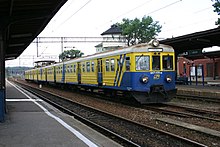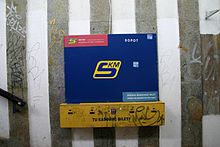PKP Szybka Kolej Miejska w Trójmieście
| PKP Szybka Kolej Miejska w Trójmieście |
|||||||||||||||||||
|
|||||||||||||||||||
The PKP Szybka Kolej Miejska w Trójmieście Sp. Z oo ( German literally Stadtschnellbahn in der Tristadt ) is a S-Bahn -like system that connects the cities of Gdańsk ( Danzig ), Sopot ( Sopot ) and Gdynia ( Gdingen ) ( Tricity ) connects. Over the years, however, the catchment area was expanded so that the cities of Słupsk , Lębork , Wejherowo and Tczew can now be reached. The main part, however, is the Gdańsk – Rumia line , where the SKM has its own track structure.
General
operator
The SKM is operated by PKP Szybka Kolej Miejska w Trójmieście , a subsidiary of the Polish state railways PKP . It was originally part of the company, but in 2001 it was spun off as a subsidiary.
SKM is one of the most profitable companies within the PKP Group and is often active as a sponsor in Tricity .
In 2008 SKM employed 843 people.
vehicles
Currently, multiple units of the Polish EN57 and EN71 series are mainly used. Some of the trains have already been modernized and are now handicapped accessible. The responsible railway depot Gdynia Cisowa Elektrowozownia is located between Gdynia and Rumia .
The trains have doors on both sides and can therefore be used as a push-pull train . Although the SKM stations mostly have elevated platforms , the trains can in principle stop at low platforms. The current design stipulates that the SKM vehicles should be painted uniformly in yellow (window band) and blue (rest of the body). But not all multiple units have been repainted yet.
Tickets
There is currently no transport association in the Tricity, but this is being planned. So far, passengers have had to buy different tickets for the trams and buses in Gdansk , the buses in Sopot , the trolleybuses in Gdynia and for the SKM. The SKM tickets cost between 2.20 and 6.60 złoty , depending on the route (this corresponded to around 0.51 to 1.55 € in April 2009 ). There are also season tickets and discounts for schoolchildren and students. Tickets from other PKP companies are not valid. Passengers without a valid ticket have to pay an increased fee of 100 zł (approx. € 25.86).
Since January 2007, tickets can also be purchased from machines that are initially only set up at busy train stations (including Gdańsk Główny ).
Train stations
Of the total of 27 stops between Gdansk and Wejherowo, eight are long-distance train stations. Within Gdansk, there are mainly central platforms (the trains to Gdansk stop on the western platform), while there are mainly side platforms on the branch lines. Many stops are in poor condition and are gradually being renovated by SKM. The line to the Nowy Port (Neufahrwasser) district has been completely closed since 2005. The old stations on this section of the route, some of which date from before the Second World War , still exist, but are falling into disrepair.
Over 90% of the stops are connected to other means of transport ( buses , trams ).
history
Until 1945
The first work on the route from Gdańsk to Sopot began in 1912, but mainly demolition work on the planned route. The project was interrupted by the outbreak of the First World War. After the war the area was separated from the German Empire. Gdynia became part of the Republic of Poland , the rest of the area became part of the Free City of Danzig (as a partially independent republic administered by the League of Nations), in which the railway operation according to Article 104 of the Versailles Treaty was handled by the PKP. Work on the route was initially discontinued.
post war period
After the end of the Second World War, the PKP took over 189 vehicles from the S-Bahn Berlin (series ET / EB 165 , ET / EB 166 and ET / EB 167 ) that were staying in the Reichsbahnausbesserungswerk (RAW) Schweidnitz (Silesia) for repairs and after the end of the war initially collected in the former RAW Lauban (Silesia). From this (initially larger) inventory, the Soviet Union brought vehicles to Moscow, Kiev and Tallinn. (More vehicles followed from Berlin to the SU.)
The workshop in Lauban refurbished the first trains for electric suburban traffic in Danzig (previously also trains for suburban traffic in Warsaw). These received pantographs for overhead lines instead of the busbar common in Berlin ; the operating voltage of 750 volts remained unchanged. In addition, the trains got large headlights typical of PKP (combined peak and tail signal), and the trains of the ET / EB 167 series did not have the automatic control current coupling on the Scharfenberg coupling ("piano"); Instead, the trains were uniformly converted to the older plug-socket coupling. The first depot was set up at the Gdańsk Zaspa Towarowa station. First 80 quarter trains were converted.
In October 1950, the decision was finally made to operate the suburban railway on its own tracks. Until the start of operations in 1952, only the line to Gdańsk Wrzeszcz (Langfuhr) was double-track, the second track in the direction of Sopot was completed in June 1952. From this point on, a 10-minute cycle was established. The route was continued as follows:
- July 22, 1952: Gdynia Orłowo
- 1954: Gdynia Główna
- 1956: Gdynia Chylonia
- December 31, 1957: Wejherowo
On the section between Gdynia and Wejherowo, the long-distance tracks are also used. The new means of transport was well received: as early as 1959, more than 50 million passengers per year were carried for the first time, and according to a survey from this time, over 152,700 people lived no further than 800 meters from an SKM stop.
Unrealized expansion plans
Initially, the line was to be expanded south to Pruszcz Gdański , but the plan was soon abandoned due to the supply lines being too close to the line. The line between Gdansk and Nowy Port was temporarily operated in test operation with 1500 V, but the engines of the vehicles designed for 800 V proved to be unreliable under 1500 V. In the 1960s there were plans to connect the city of Gdańsk from Wrzeszcz with Kokoszki and Kartuzy . Today it is unclear why these plans were not carried out as the costs would have been low. To the east of the main line, the connection between Zaspa Towarowa and Sopot was also to be built in order to relieve the main line. This plan was not implemented.
The 1970s and 80s
The utilization of the routes grew more and more (in 1975 100 million passengers were carried) and the old Berlin vehicles were increasingly prone to failure. In the middle of the 1970s, long-distance rail electrification reached the Tricity with the 3000 V DC voltage customary in Poland, so that operation was gradually switched from 800 V to 3000 V. Since the section to Wejherowo was converted to 3000 V operation, it was necessary to procure new trains. By 1976, the trains from Berlin were therefore retired and replaced by the EN57. A new depot was built in Gdynia Cisowa, and construction of the line to Rumia started from Gdynia . On December 20, 1976, operation was switched from 800 V to 3000 V. This caused many problems, not least because parts of the public were not informed about the conversion measures that took several days.
In the 1980s there were no further expansions, only the measures that had already started in the previous decade were continued. Between 1986 and 1990 there were several trains a day to Żarnowiec , where the Żarnowiec nuclear power plant was to be built. After the construction work was stopped due to protests from the population, the line was stopped again.
The 1990s and the present
The fall of the Iron Curtain brought about major economic changes in Poland, including an increase in private transport at the expense of local public transport. In the course of the 1990s, the number of passengers halved from initially around 80 million to around 40 million per year. In 2001, SKM was spun off from PKP, and in 2005 the line to Nowy Port was finally closed (the end point had been abandoned a few years earlier). From 2003 to December 10, 2005 the SKM operated individual trains on the routes to Iława , Lębork and Elbląg , but had to stop these services to Iława and Elbląg. In return, operations were started in Slupsk .
Today the route is operated around the clock. During the day a train runs to Gdynia Cisowa at least every 15 minutes on weekdays, and significantly more frequently during rush hour. Most trains continue to Wejherowo. Trains run approximately every hour from midnight to around 4:30 a.m. Eleven pairs of trains run to Słupsk on weekdays and a little less on weekends.
In 2015 a second connection between Gdańsk and Gdynia was put into operation. This route , which connects the airport , is not electrified and is being used with new diesel traction vehicles. It is operated by a subsidiary of SKM, PKM .
Board of Directors of PKP SKM
- 2001 to 2006 - Mikołaj Segień
- 2006 to 2009 - Andrzej Osipów
- since 2009 - Maciej Lignowski






